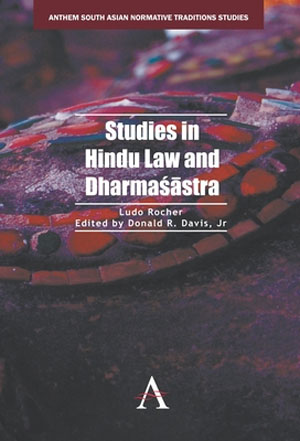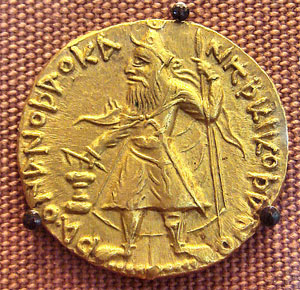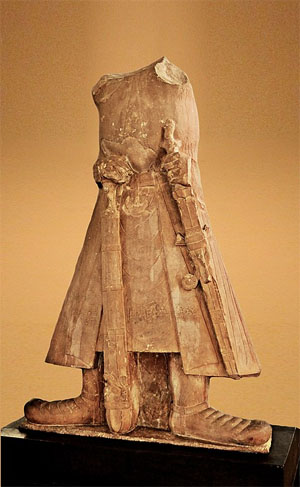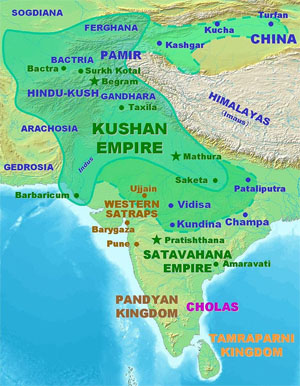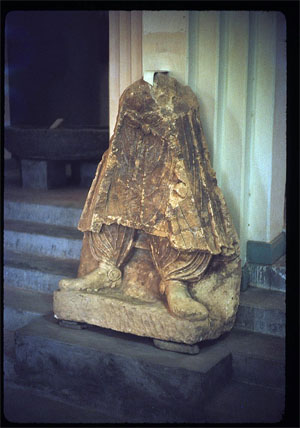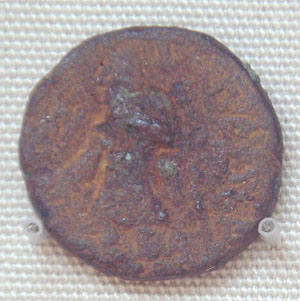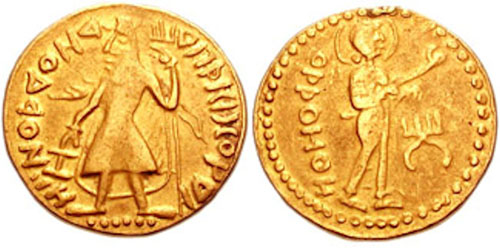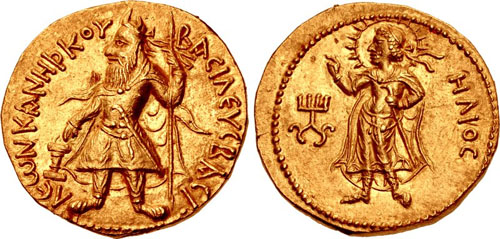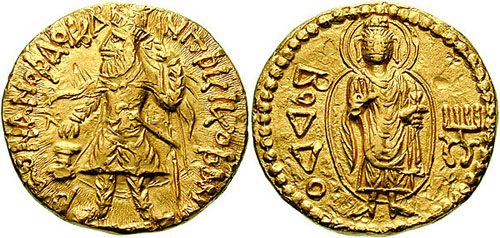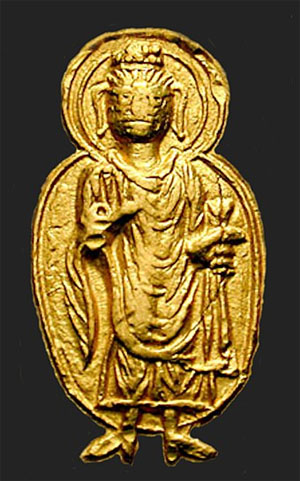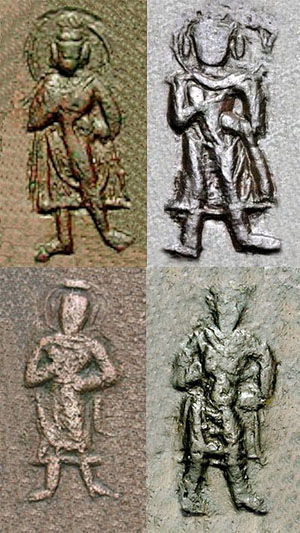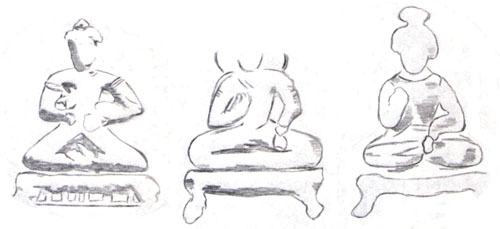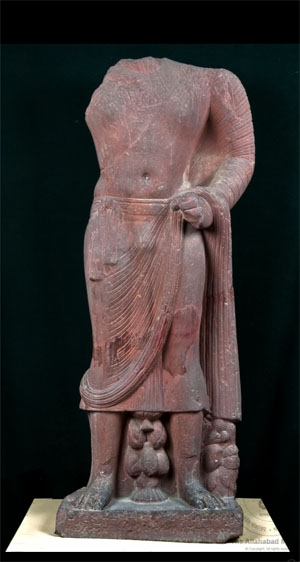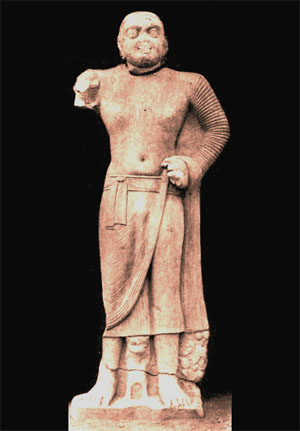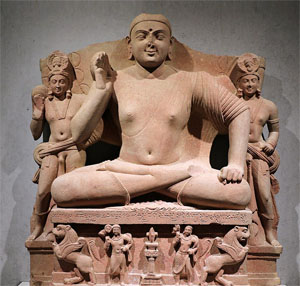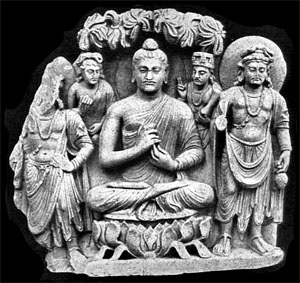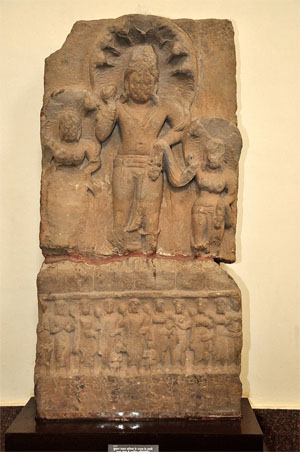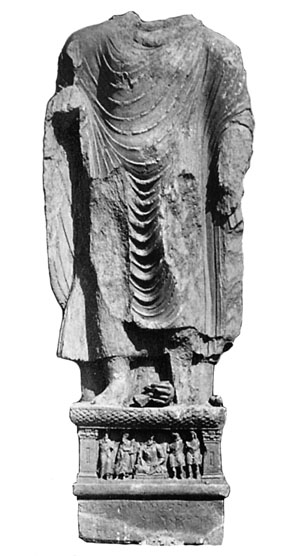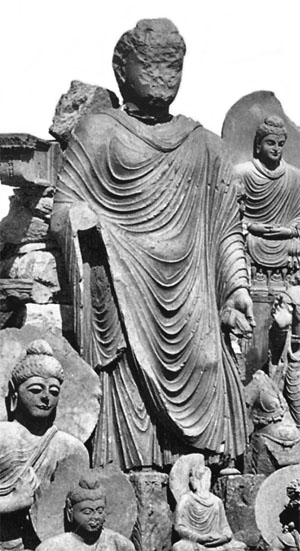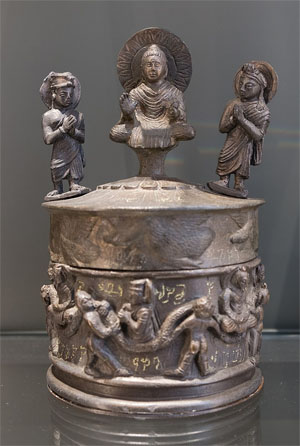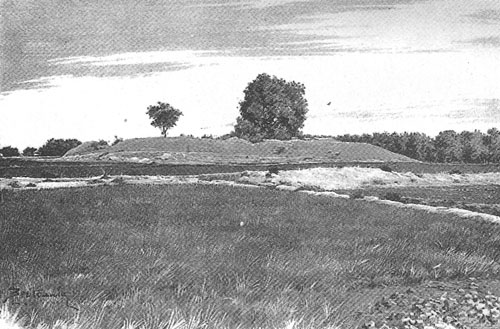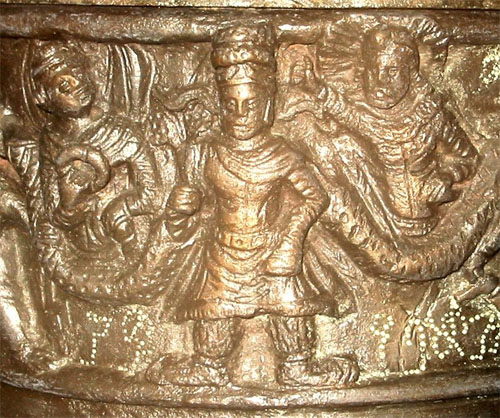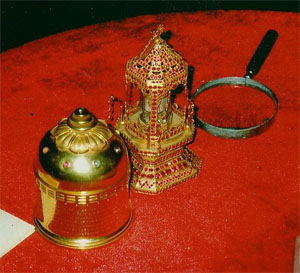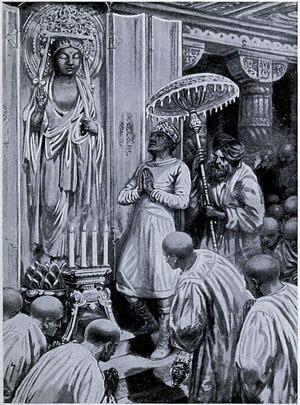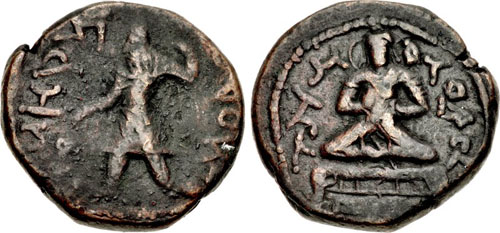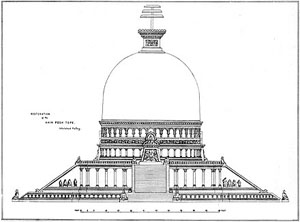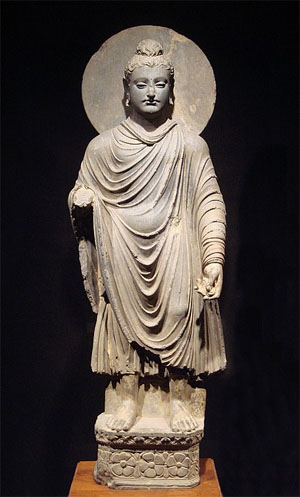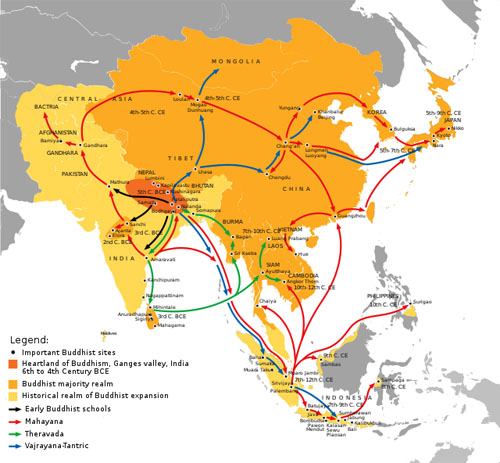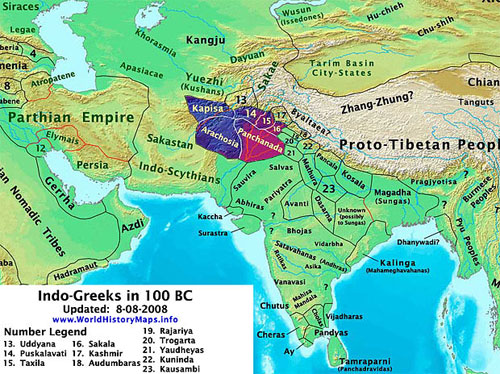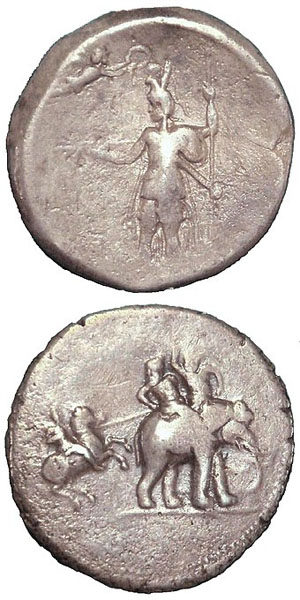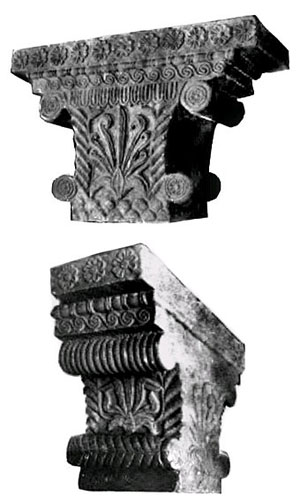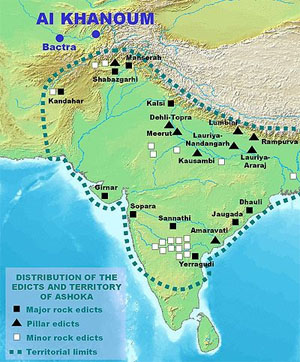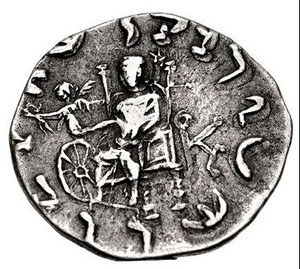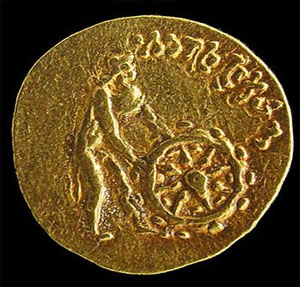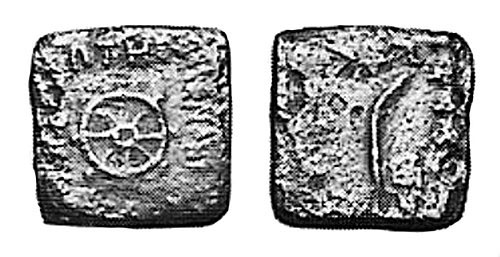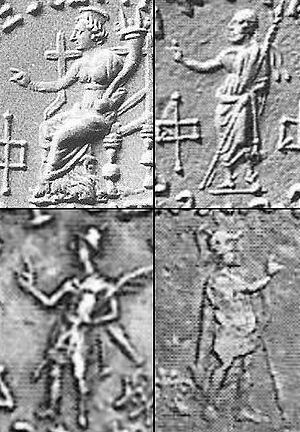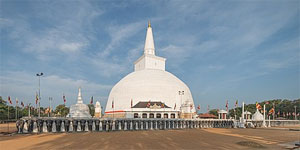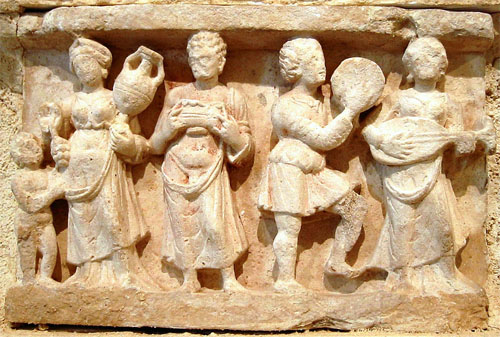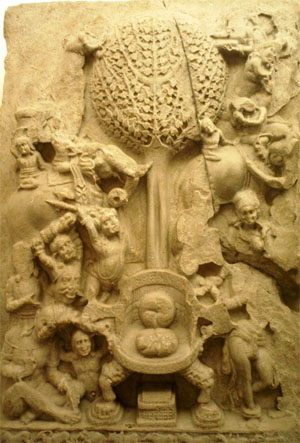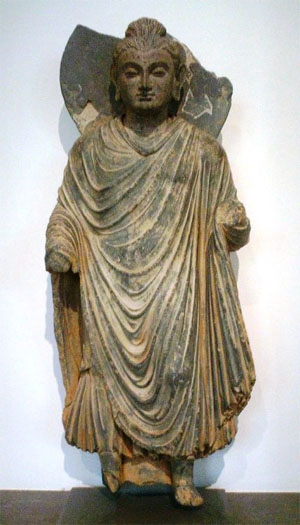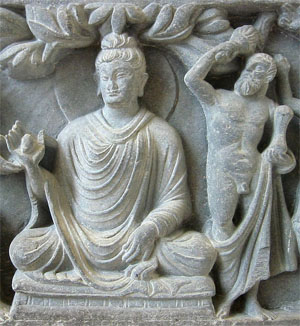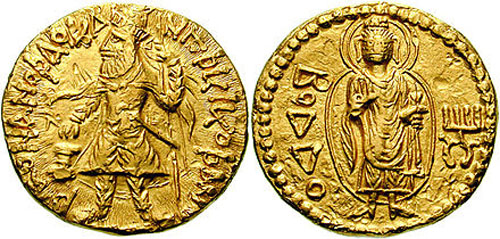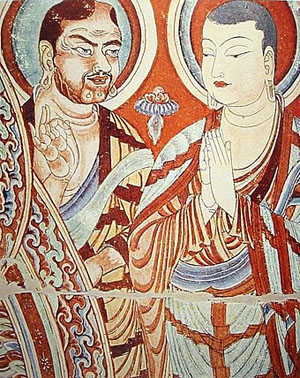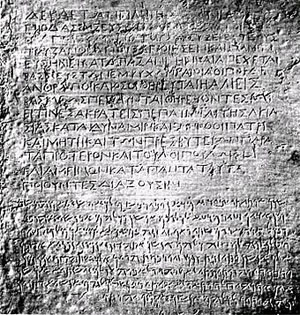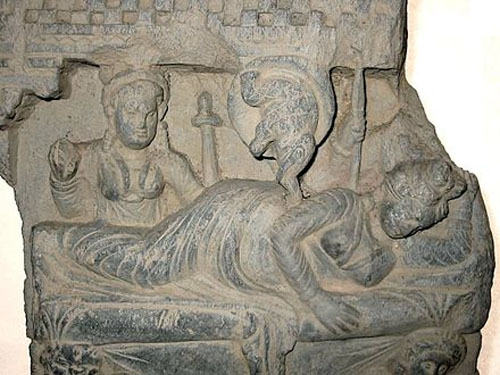Pāṇiniby Wikipedia
Accessed: 9/3/21
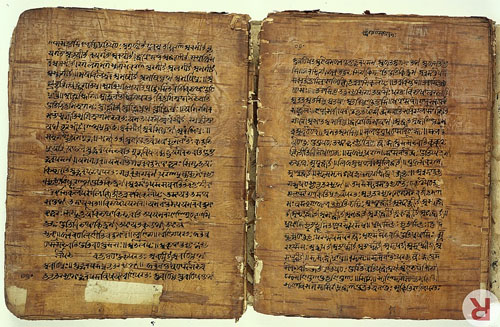
Pāṇini
A 17th-century birch bark manuscript of Pāṇini's grammar treatise from KashmirNotable work
Aṣṭādhyāyī (Classical Sanskrit)
Era fl. 4th century BCE;[1][2][3];
fl. 400–350 BCE[4];
6th–5th century BCE[5][6][note 1]
Region Northwest Indian subcontinent[note 2]
The greatest linguist of antiquity
Pāṇini.. was the greatest linguist of antiquity, and deserves to be treated as such.
— JF Staal, A reader on the Sanskrit Grammarians[8]
Pāṇini was a Sanskrit philologist, grammarian, and revered scholar in ancient India,[7][9][10]
variously dated between the 6th[5][6][note 1] and 4th century BCE.[1][2][3][4]
Since the
discovery and publication of his work by European scholars in the nineteenth century, Pāṇini has been considered the "first descriptive linguist",[11] and even labelled as “the father of linguistics”.[12][13][14]
Pāṇini's grammar was influential on such foundational linguists as Ferdinand de Saussure and Leonard Bloomfield.[15]
LegacyPāṇini is known for his text Aṣṭādhyāyī, a sutra-style treatise on Sanskrit grammar,[10][7] 3,959 verses or rules on linguistics, syntax and semantics in "eight chapters" which is the foundational text of the Vyākaraṇa branch of the Vedanga, the auxiliary scholarly disciplines of the Vedic period.[16][17][18] His aphoristic text attracted numerous bhashya (commentaries), of which
Patanjali's Mahābhāṣya is the most famous in Hindu traditions.[19]His ideas influenced and attracted commentaries from scholars of other Indian religions such as Buddhism.[20]
Pāṇini's analysis of noun compounds still forms the basis of modern linguistic theories of compounding in Indian languages.
Pāṇini's comprehensive and scientific theory of grammar is conventionally taken to mark the start of Classical Sanskrit.[21] His systematic treatise inspired and made Sanskrit the preeminent Indian language of learning and literature for two millennia.
Pāṇini's theory of morphological analysis was more advanced than any equivalent Western theory before the 20th century.[22] His treatise is generative and descriptive, uses metalanguage and meta-rules, and
has been compared to the Turing machine wherein the logical structure of any computing device has been reduced to its essentials using an idealized mathematical model.[23]
Father of linguistics
The history of linguistics begins not with Plato or Aristotle, but with the Indian grammarian Panini.
— Rens Bod, University of Amsterdam[24]
Pāṇini likely lived in Śalatura in ancient Gandhāra in the northwest Indian subcontinent[a] during the Mahājanapada era.[25][4]
The name Pāṇini is a patronymic meaning descendant of Paṇina.[26]
His full name was "Dakṣiputra Pāṇini" according to verses 1.75.13 and 3.251.12 of Patanjali's Mahābhāṣya, with the first part suggesting his mother's name was Dakṣi.[6]
DatingNothing definite is known about when Pāṇini lived, not even in which century he lived. Pāṇini has been dated between the seventh[27] or sixth[6] and fourth century BCE.[28][1][2][3][4][note 1] Von Hinüber (1989) based on numismatic arguments [coins] and Falk (1993) based on his Indic script studies, place him in mid-fourth century BCE.[28][1][2][3] Others use internal evidence and textual evidence in ancient Indian texts to date him in the sixth or fifth century BCE,[6] while Bod mentions the seventh to fifth century BCE.[24] George Cardona (1997) in his authoritative survey and review of Pāṇini-related studies, states that the available evidence strongly supports a dating no later than between 400 to 350 BCE, while earlier dating depends on interpretations and is not probative.[29]
According to Bod, Pāṇini's grammar defines Classical Sanskrit, so Pāṇini is chronologically placed in the later part of the Vedic period.[24] According to A. B. Keith, the Sanskrit text that most matches the language described by Pāṇini is the Aitareya Brāhmaṇa (8th-6th c. BCE).[30] According to Scharfe, "his proximity to the Vedic language as found in the Upanisads and Vedic sūtras suggests the 5th or maybe 6th c. B.C."[6]
Based on numismatic findings, Von Hinüber and Falk place Pāṇini in the mid-4th century BCE.
Pāṇini's rupya (A 5.2.120) mentions a specific coin which was introduced in India in the 4th-century BCE.[3] According to Houben, "the date of "ca. 350 B.C.E. for Pāṇini is thus based on concrete evidence which till now has not been refuted."[3] According to Bronkhorst, there is no reason to doubt the validity of Von Hinüber's and Falk's argument, setting the terminus post quem[ b] for the date of Pāṇini at 350 BCE or the decades thereafter. [28] According to Bronkhorst,
...thanks to the work carried out by Hinüber (1990:34-35) and Falk (1993: 303-304), we now know that Pāṇini lived, in all probability, far closer in time to the period of Aśoka than had hitherto been thought. According to Falk's reasoning, Panini must have lived during the decennia following 350 BCE, i.e. just before (or contemporaneously with?) the invasion of Alexander of Macedonia[2]
Cardona mentions two major pieces of internal evidence for the dating of Pāṇini.[31] The occurrence of the word yavanānī in 4.1.49, referring to a writing (lipi) c.q. cuneiform writing, or to Greek writing, suggests a date for Pāṇini after Alexander the Great. Cardona rejects this possibility, arguing that yavanānī may also refer to a Yavana woman; and that Indians had contacts with the Greek world before Alexander's conquests.[32][note 3] Sutra 2.1.70 of Pāṇini mentions kumāraśramaṇa, derived from śramaṇa, which refers to a female renunciates, c.q. "Buddhist nuns," implying that Pāṇini should be placed after Gautama Buddha. K. B. Pathak (1930) argued that kumāraśramaṇa could also refer to a Jain nun, meaning that Pāṇini is not necessarily to be placed after the Buddha.[31]It is not certain whether Pāṇini used writing for the composition of his work, though it is generally agreed that he knew of a form of writing, based on references to words such as lipi ("script") and lipikara ("scribe") in section 3.2 of the Aṣṭādhyāyī.[35][36][37] The dating of the introduction of writing in India may therefore give further information on the dating of Pāṇini.[note 4]
Pāṇini cites at least ten grammarians and linguists before him: Āpiśali, Kāśyapa, Gārgya, Gālava, Cākravarmaṇa, Bhāradvāja, Śākaṭāyana, Śākalya, Senaka and Sphoṭāyana.[44] According to Kamal K. Misra, Pāṇini also refers to Yaska, "whose writings date back to the middle of the 4th century B.C."[45] Both Brihatkatha and Mañjuśrī-mūla-kalpa mention Pāṇini to have been a contemporary with the Nanda king (4th c. BCE).[46]
LocationNothing certain is known about Pāṇini's personal life. In an inscription of Siladitya VII of Valabhi, he is called Śalāturiya, which means "man from Salatura". This means Panini lived in Salatura of ancient Gandhara (present day north-west Pakistan), which likely was near Lahor, a town at the junction of Indus and Kabul rivers.[d][47][48] According to the memoirs of 7th-century Chinese scholar Xuanzang, there was a town called Suoluoduluo on the Indus where Pāṇini was born, and he composed the Qingming-lun (Sanskrit: Vyākaraṇa).[47][49][50]
According to Hartmut Scharfe, Pāṇini lived in Gandhara close to the borders of the Achaemenid Empire, and Gandhara was then an Achaemenian satrapy following the Achaemenid conquest of the Indus Valley.
He must, therefore, have been technically a Persian subject but his work shows no awareness of the Persian language.[6][51] According to Patrick Olivelle, Pāṇini's text and references to him elsewhere suggest that "he was clearly a northerner, probably from the northwestern region".[52]
Legends and later receptionPanini is mentioned in Indian fables and ancient texts. The Panchatantra, for example, mentions that Pāṇini was killed by a lion.[53][54][55]
Pāṇini was depicted on a five-rupee Indian postage stamp in August, 2004.[56][57][58][59]
AṣṭādhyāyīMain article: Aṣṭādhyāyī
The most important of Pāṇini's works, the Aṣṭādhyāyī is a grammar that essentially defines the Sanskrit language. Modeled on the dialect and register of elite speakers in his time, the text also accounts for some features of the older Vedic language.
The Aṣtādhyāyī is a prescriptive and generative grammar with algebraic rules governing every aspect of the language. It is supplemented by three ancillary texts: akṣarasamāmnāya, dhātupāṭha[A] and gaṇapāṭha.[ b][60]
Growing out of a centuries-long effort to preserve the language of the Vedic hymns from 'corruption', the Aṣtādhyāyī is
the high point of a vigorous, sophisticated grammatical tradition devised to arrest language change. The Aṣtādhyāyī's preeminence is underlined by the fact that it eclipsed all similar works that came before: while not the first,
it is the oldest such text surviving in its entirety.[61][62][63][64]
The Aṣṭādhyāyī consists of 3,959 sūtras[C] in eight chapters, which are each subdivided into four sections or pādas. The text takes material from lexical lists (dhātupāṭha, gaṇapātha) as input and describes algorithms to be applied to them for the generation of well-formed words.
The Aṣṭādhyāyī, composed in an era when oral composition and transmission was the norm, is staunchly embedded in that oral tradition. In order to ensure wide dissemination, Pāṇini is said to have preferred brevity over clarity[65] -
it can be recited end-to-end in two hours. This has led to the emergence of a great number of commentaries[α] of his work over the centuries, which for the most part adhere to the foundations laid by Pāṇini's work.[66][61]
BhaṭṭikāvyaMain article: Bhaṭṭikāvya
The learning of Indian curriculum in late classical times had at its heart a system of grammatical study and linguistic analysis.[67] The core text for this study was the Aṣṭādhyāyī of Pāṇini, the sine qua non of learning.[68] This grammar of Pāṇini had been the object of intense study for the ten centuries prior to the composition of the Bhaṭṭikāvya. It was plainly Bhaṭṭi's purpose to provide a study aid to Pāṇini's text by using the examples already provided in the existing grammatical commentaries in the context of the gripping and morally improving story of the Rāmāyaṇa. To the dry bones of this grammar Bhaṭṭi has given juicy flesh in his poem. The intention of the author was to teach this advanced science through a relatively easy and pleasant medium. In his own words:
This composition is like a lamp to those who perceive the meaning of words and like a hand mirror for a blind man to those without grammar. This poem, which is to be understood by means of a commentary, is a joy to those sufficiently learned: through my fondness for the scholar I have here slighted the dullard.
-- Bhaṭṭikāvya 22.33–34.
Modern linguisticsPāṇini's work became known in 19th-century Europe, where it influenced modern linguistics initially through Franz Bopp, who mainly looked at Pāṇini. Subsequently, a wider body of work influenced Sanskrit scholars such as Ferdinand de Saussure, Leonard Bloomfield, and Roman Jakobson. Frits Staal (1930–2012) discussed the impact of Indian ideas on language in Europe. After outlining the various aspects of the contact, Staal notes that the idea of formal rules in language – proposed by Ferdinand de Saussure in 1894 and developed by Noam Chomsky in 1957 – has origins in the European exposure to the formal rules of Pāṇinian grammar.[69] In particular, de Saussure, who lectured on Sanskrit for three decades, may have been influenced by Pāṇini and Bhartrihari; his idea of the unity of signifier-signified in the sign somewhat resembles the notion of Sphoṭa. More importantly, the very idea that formal rules can be applied to areas outside of logic or mathematics may itself have been catalysed by Europe's contact with the work of Sanskrit grammarians.[69]
De SaussurePāṇini, and the later Indian linguist Bhartrihari, had a significant influence on many of the foundational ideas proposed by Ferdinand de Saussure, professor of Sanskrit, who is widely considered the father of modern structural linguistics and with Charles S. Peirce on the other side, to semiotics, although the concept Saussure used was semiology. Saussure himself cited Indian grammar as an influence on some of his ideas. In his Mémoire sur le système primitif des voyelles dans les langues indo-européennes (Memoir on the Original System of Vowels in the Indo-European Languages) published in 1879, he mentions Indian grammar as an influence on his idea that "reduplicated aorists represent imperfects of a verbal class." In his De l'emploi du génitif absolu en sanscrit (On the Use of the Genitive Absolute in Sanskrit) published in 1881, he specifically mentions Pāṇini as an influence on the work.[70]
Prem Singh, in his foreword to the reprint edition of the German translation of Pāṇini's Grammar in 1998, concluded that the "effect Panini's work had on Indo-European linguistics shows itself in various studies" and that a "number of seminal works come to mind," including Saussure's works and the analysis that "gave rise to the laryngeal theory," further stating: "This type of structural analysis suggests influence from Panini's analytical teaching." George Cardona, however, warns against overestimating the influence of Pāṇini on modern linguistics: "Although Saussure also refers to predecessors who had taken this Paninian rule into account, it is reasonable to conclude that he had a direct acquaintance with Panini's work. As far as I am able to discern upon rereading Saussure's Mémoire, however, it shows no direct influence of Paninian grammar. Indeed, on occasion, Saussure follows a path that is contrary to Paninian procedure."[70][71]
Leonard BloomfieldThe founding father of American structuralism, Leonard Bloomfield, wrote a 1927 paper titled "On some rules of Pāṇini".[72]
Comparison with modern formal systemsPāṇini's grammar is the world's first formal system, developed well before the 19th century innovations of Gottlob Frege and the subsequent development of mathematical logic.
In designing his grammar, Pāṇini used the method of "auxiliary symbols", in which new affixes are designated to mark syntactic categories and the control of grammatical derivations. This technique, rediscovered by the logician Emil Post, became a standard method in the design of computer programming languages.[73][74] Sanskritists now accept that Pāṇini's linguistic apparatus is well-described as an "applied" Post system.
Considerable evidence shows ancient mastery of context-sensitive grammars, and a general ability to solve many complex problems. Frits Staal has written that "Panini is the Indian Euclid."Other worksTwo literary works are attributed to Pāṇini, though they are now lost.Jāmbavati Vijaya is a lost work cited by Rajashekhara in Jalhana's Sukti Muktāvalī. A fragment is to be found in Ramayukta's commentary on Namalinganushasana. From the title it may be inferred that the work dealt with Krishna's winning of Jambavati in the underworld as his bride. Rajashekhara in Jahlana's Sukti Muktāvalī:
नमः पाणिनये तस्मै यस्मादाविर भूदिह।
आदौ व्याकरणं काव्यमनु जाम्बवतीजयम्॥
namaḥ pāṇinaye tasmai yasmādāvirabhūdiha।
ādau vyākaraṇaṃ kāvyamanu jāmbavatījayam॥
Ascribed to Pāṇini, Pātāla Vijaya is a lost work cited by Namisadhu in his commentary on Kavyalankara of Rudrata.
There are many mathematical works related to Pāṇini's works. Pāṇini came up with a plethora of ideas to organize the known grammatical forms of his day in a systematic way. Like any mathematician who models a known phenomenon in mathematical language, Pāṇini created a metalanguage and it is very close to the modern-day ideas of algebra. See "Mathematical Structures of Panini's Ashtaadhyayi" by Bhaskar Kompella.
See also• Vyākaraṇa
• Bhaṭṭikāvya
• Pingala
• Mahajanapadas
• Seṭ and aniṭ roots
• Tolkappiyam
• List of Indian mathematicians
Notes1. in what is now modern day Pakistan
2. the earliest time an event may have happened
3. Ionian
4. which falls in the Swabi District of modern Pakistan
1. 4th century BCE date:
Johannes Bronkhorst (2019): "Pāṇini's Aṣṭādhyāyī has been the target of much guesswork as to its date. Only recently have more serious proposals been made. Oskar von Hinüber (1990: 34) arrives, on the basis of a comparison of Pāṇini's text with numismatic findings, at a date that can hardly be much earlier than 350 BCE; Harry Falk (1993: 304; 1994: 327 n. 45) refines these reflections and moves the date forward to the decennia following 350 BCE. If Hinüber and Falk are right, and there seems no reason to doubt this, we have here for Pāṇini a terminus post quem.[28]
Vincenzo Vergiani (2017): "For a survey of scholarship about Panini's date see George cardona, Panini: A Survey of Research (Delhi: Motilall Banarsidass, 1980), p.260-262. Oskar von Hinüber, Der Beginn der Schrift und fruhe Schriftlichkeit in Indien (Wiesbaden: Steiner Verlag, 1989), p.34 presents evidence that suggests dating Panini to the 4th century."[1]
Johannes Bronkhorst (2016)"...thanks to the work carried out by Hinüber (1990:34-35) and Falk (1993: 303-304), we now know that Pāṇini lived, in all probability, far closer in time to the period of Asoka than had hitherto been thought. According to Falk's reasoning, Panini must have lived during the decennia following 350 BCE, i.e. just before (or contemporaneously with?) the invasion of Alexander of Macedonia."[2]
Jan E.M Houben (2009): "Pāṇini's rupya (A 5.2.120) refers to a type of coin which appeared in the Indian subcontinent only from the 4th century B.C.E. onwards: cf. von Hinüber 1989: p.34 and Falk 1993: 304. The date of "ca. 350 B.C.E. for Pāṇini is thus based on concrete evidence which till now has not been refuted."[3]
Michael Witzel (2009): "c. 350 BCE"[75]
Kamal K. Misra (2000): "But Pāṇini himself has acknowledged at least ten great Indian grammatrians before him, and one of them was Yaska, whose writings date back to the middle of the 4th century B.C."[45]
Cardona: "The evidence for dating Panini, Katyayana and Patanjali is not absolutely probative and depends on interpretation. However, I think there is one certainty, namely that the evidence available hardly allows one to date Panini later than the early to mid fourth century B. C."[4]
Harry Falk (1993), Schrift im alten Indien: ein Forschungsbericht mit Anmerkungen, Gunter Narr Verlag
Frits Staal (1965): "fourth century B.C."[76]
6th or 5th century BCE date:
Frits Staal (1996): "the Sanskrit grammar of Panini (6th or 5th century b.c.e.)"[5]
Hartmut Scharfe (1977): "Panini's date can be fixed only approximately; he must be older than Katyayana (c. 250 B.C.) who in his comments on Panini's work refers to other [stni] earlier scholars dealing with Panini's grammar; his proximity to the Vedic language as found in the Upanisads and Vedic sutra's suggests the 5th or maybe 6th c. B.C."[6] Scharfe refers to: "F. Kielhoek, GGN 1885.186f.; B. Liebich, BB 10.205-234; 11.273-315 and his book, Panini(Leipzig, 1891), p. 38-50; 0. Wecker, BB 30. 1-61+177-207; P. Thieme, Panini and the Veda(Allahabad, 1935), p. 75-81."[6]
Encyclopedia Britannica: "Ashtadhyayi, Sanskrit Aṣṭādhyāyī ("Eight Chapters"), Sanskrit treatise on grammar written in the 6th to 5th century BCE by the Indian grammarian Panini."
7th to 5th century BCE date
Rens Bod (2013): "All we know is that he was born in Ghandara, in former India (currently Afghanistan), and that it must have been between the seventh and fifth centuries BCE."[27] Bod refers to "S. Shukla, 'Panini', Encyclopedia of Language & Linguistics, 2nd edition, Elsevier, 2006. See also Paul Kiparsky, 'Paninian Linguistics', Encyclopedia of Language and Linguistics, 1st edition, Elsevier, 1993."[77]
2. According to George Cardonna, the tradition believes that Pāṇini came from Salatura in northwest part of the Indian subcontinent.[4] This is likely to be ancient Gandhara.[7]
3. In 1862 Max Müller argued that yavana may have meant "Greek"[c] during Pāṇinis time, but may also refer to Semitic or dark-skinned Indian people.[33][34]
4.
Pāṇini's use of the term lipi has been a source of scholarly disagreements. Harry Falk in his 1993 overview states that ancient Indians neither knew nor used writing script, and Pāṇini's mention is likely a reference to Semitic and Greek scripts.[38] In his 1995 review, Salomon questions Falk's arguments and writes it is "speculative at best and hardly constitutes firm grounds for a late date for Kharoṣṭhī. The stronger argument for this position is that
we have no specimen of the script before the time of Aśoka, nor any direct evidence of intermediate stages in its development; but of course this does not mean that such earlier forms did not exist, only that, if they did exist, they have not survived, presumably because they were not employed for monumental purposes before Aśoka".[39] According to Hartmut Scharfe, Lipi of Pāṇini may be borrowed from the Old Persian Dipi, in turn derived from Sumerian Dup.
Scharfe adds that the best evidence, at the time of his review, is that no script was used in India, aside from the Northwest Indian subcontinent, before around 300 BCE because Indian tradition "at every occasion stresses the orality of the cultural and literary heritage."[40] Kenneth Norman states writing scripts in ancient India evolved over the long period of time like other cultures, that it is unlikely that ancient Indians developed a single complete writing system at one and the same time in the Maurya era. It is even less likely, states Norman, that a writing script was invented during Ashoka's rule, starting from nothing, for the specific purpose of writing his inscriptions and then it was understood all over South Asia where the Aśoka pillars are found.[41] Jack Goody states that ancient India likely had a "very old culture of writing" along with its oral tradition of composing and transmitting knowledge, because the Vedic literature is too vast, consistent and complex to have been entirely created, memorized, accurately preserved and spread without a written system.[42] Falk disagrees with Goody, and suggests that it is a Western presumption and inability to imagine that remarkably early scientific achievements such as Pāṇini's grammar (5th to 4th century BCE), and the creation, preservation and wide distribution of the large corpus of the Brahmanic Vedic literature and the Buddhist canonical literature, without any writing scripts. Johannes Bronkhorst disagrees with Falk, and states, "Falk goes too far. It is fair to expect that we believe that Vedic memorisation — though without parallel in any other human society — has been able to preserve very long texts for many centuries without losing a syllable. (...) However,
the oral composition of a work as complex as Pāṇini's grammar is not only without parallel in other human cultures, it is without parallel in India itself. (...) It just will not do to state that our difficulty in conceiving any such thing is our problem".[43]
Glossary1. dhātu: root, pāṭha: reading, lesson
2. gaṇa: class
3. aphoristic threads
Traditional glossary and notes1. bhāṣyas
References1. Vergiani 2017, p. 243, n.4.
2. Bronkhorst 2016, p. 171.
3. Houben 2009, p. 6.
4. Cardona 1997, p. 268.
5. Staal 1996, p. 39.
6. Scharfe 1977, p. 88.
7. Staal 1965.
8. Staal 1972, p. xi.
9. Lidova 1994, p. 108-112.
10. Lochtefeld 2002a, p. 64–65, 140, 402.
11. François & Ponsonnet (2013: 184).
12. Bod 2013, p. 14-19.
13. Patañjali; Ballantyne, James Robert; Kaiyaṭa; Nāgeśabhaṭṭa (1855). Mahābhāṣya …. Mirzapore. OCLC 47644586.
14. Pāṇini; Boehtlingk, Otto von (1886). Panini's Grammatik, herausgegeben, übersetzt, erläutert… von O. Böhtlingk. Sansk. and Germ. Leipzig. OCLC 562865694.
15. Henry), Robins, R. H. (Robert (1997). A short history of linguistics (4th ed.). London: Longman. ISBN 0582249945. OCLC 35178602.
16. W. J. Johnson (2009), A Dictionary of Hinduism, Oxford University Press, ISBN 978-0198610250, article on Vyakarana
17. Harold G. Coward 1990, p. 105.
18. Lisa Mitchell (2009). Language, Emotion, and Politics in South India. Indiana University Press. p. 108. ISBN 978-0-253-35301-6.
19. James G. Lochtefeld (2002). The Illustrated Encyclopedia of Hinduism: N-Z. The Rosen Publishing Group. p. 497. ISBN 978-0-8239-3180-4.
20. Hartmut Scharfe (1977). Grammatical Literature. Otto Harrassowitz Verlag. pp. 152–154. ISBN 978-3-447-01706-0.
21. Yuji Kawaguchi; Makoto Minegishi; Wolfgang Viereck (2011). Corpus-based Analysis and Diachronic Linguistics. John Benjamins Publishing Company. pp. 223–224. ISBN 978-90-272-7215-7.
22. Staal, Frits (1988). Universals: studies in Indian logic and linguistics. University of Chicago Press. p. 47. ISBN 9780226769998.
23. Kak, Subhash C. (January 1987). "The Paninian approach to natural language processing". International Journal of Approximate Reasoning. 1 (1): 117–130. doi:10.1016/0888-613X(87)90007-7.
24. Bod 2013, p. 14-18.
25. Avari, Burjor (2007). India: The Ancient Past: A History of the Indian Sub-Continent from c. 7000 BC to AD 1200. Routledge. p. 156. ISBN 978-1-134-25161-2.
26. Pāṇini; Sumitra Mangesh Katre (1989). Aṣṭādhyāyī of Pāṇini. Motilal Banarsidass. p. xx. ISBN 978-81-208-0521-7.
27. Bod 2013, p. 14.
28. Bronkhorst 2019.
29. Cardona 1997, pp. 261–268; Quote: ".
30. Keith, Arthur Berriedale (1998). Rigveda Brahmanas: the Aitareya and Kauṣītaki Brāhmaṇas of the Rigveda. Delhi: Motilal Banarsidass. ISBN 978-8120813595. OCLC 611413511.
31. Cardona 1997, p. 261-262.
32. Cardona 1997, p. 261.
33. Max Müller (1862). On Ancient Hindu Astronomy and Chronology. Oxford. pp. footnotes of 69–71. Bibcode:1862ahac.book.....M.
34. Patrick Olivelle (1999). Dharmasutras. Oxford University Press. p. xxxii with footnote 13. ISBN 978-0-19-283882-7.
35. Richard Salomon (1998). Indian Epigraphy: A Guide to the Study of Inscriptions in Sanskrit, Prakrit, and the other Indo-Aryan Languages. Oxford University Press. p. 11. ISBN 978-0-19-535666-3.
36. Juhyung Rhi (2009). "On the Peripheries of Civilizations: The Evolution of a Visual Tradition in Gandhāra". Journal of Central Eurasian Studies. 1: 5, 1–13.
37. Rita Sherma; Arvind Sharma (2008). Hermeneutics and Hindu Thought: Toward a Fusion of Horizons. Springer. p. 235. ISBN 978-1-4020-8192-7.
38. Falk, Harry (1993). Schrift im alten Indien: ein Forschungsbericht mit Anmerkungen (in German). Gunter Narr Verlag. pp. 109–167.
39. Salomon, Richard (1995). "Review: On the Origin of the Early Indian Scripts". Journal of the American Oriental Society. 115 (2): 271–278. doi:10.2307/604670. JSTOR 604670.
40.
Scharfe, Hartmut (2002), Education in Ancient India, Handbook of Oriental Studies, Leiden, Netherlands: Brill, pp. 10–1241. Oskar von Hinüber (1989). Der Beginn der Schrift und frühe Schriftlichkeit in Indien. Akademie der Wissenschaften und der Literatur. pp. 241–245. ISBN 9783515056274. OCLC 22195130.
42. Jack Goody (1987). The Interface Between the Written and the Oral. Cambridge University Press. pp. 110–124. ISBN 978-0-521-33794-6.
43. Johannes Bronkhorst (2002), Literacy and Rationality in Ancient India, Asiatische Studien / Études Asiatiques, 56(4), pages 803-804, 797-831
44. Cardona 1997, §1.3.
45. Misra 2000, p. 49.
46. [A History of Ancient and Early Medieval India: From the Stone Age to the 12th Century, Upinder Singh, Pearson Education India, 2008 p. 258]
47. Hartmut Scharfe (1977). Grammatical Literature. Otto Harrassowitz Verlag. pp. 88 with footnotes. ISBN 978-3-447-01706-0.
48. Saroja Bhate, Panini, Sahitya Akademi (2002), p. 4
49. Singh, Nagendra Kr., ed. (1997), Encyclopaedia of Hinduism, New Delhi: Centre for International Religious Studies : Anmol Publications, pp. 1983–2007, ISBN 978-81-7488-168-7
50. Mishra, Giridhar (1981). "प्रस्तावना" [Introduction]. अध्यात्मरामायणेऽपाणिनीयप्रयोगाणां विमर्शः[Deliberation on non-Paninian usages in the Adhyatma Ramayana] (in Sanskrit). Varanasi, India: Sampurnanand Sanskrit University. Retrieved 21 May 2013.
51. Lal, Shyam Bihari (2004). "Yavanas in the Ancient Indian Inscriptions". Proceedings of the Indian History Congress. 65: 1115–1120. ISSN 2249-1937. JSTOR 44144820.
52. Patrick Olivelle (1999). Dharmasutras. Oxford University Press. pp. xxvi–xxvii. ISBN 978-0-19-283882-7.
53. George Cardona (1997). Pāṇini: a survey of research. The verse reads siṃho vyākaraṇasya kartur aharat prāṇān priyān pāṇineḥ "a lion took the dear life of Panini, author of the grammatical treatise". The context is a list of scholars killed by animals, siṃho vyākaraṇasya kartur aharat prāṇān priyān pāṇineḥ / mīmāṃsākṛtam unmamātha sahasā hastī muniṃ jaiminim // chandojnānanidhim jaghāna makaro velātaṭe piṅgalam / ajñānāvṛtacetasām atiruṣāṃ ko'rthas tiraścām guṇaiḥ // Translation: "A lion killed Pāṇini; an elephant madly crushed the sage Jaimini, Mimamsa's author; Pingala, treasury of knowledge of poetic meter, was killed by a crocodile at the water's edge. What do senseless beasts, overcome with fury, care for intellectual virtues?" (Pañcatantra II.28, sometimes ascribed to Vallabhadeva)
54. Bhattacharyya, D. C. (1928). "Date of the Subhasitavali". Journal of the Royal Asiatic Society of Great Britain and Ireland. 60 (1): 135–137. doi:10.1017/S0035869X00059773. JSTOR 25221320.
55. Winternitz, Moriz (1963). History of Indian Literature. Motilal Banarsidass. p. 462. ISBN 978-81-208-0056-4.; Nakamura, Hajime (1983). A History of Early Vedānta Philosophy. Motilal Banarsidass. p. 400. ISBN 978-81-208-0651-1.
56. "Stamps 2004". Indian Department of Posts, Ministry of Communications & Information Technology. 23 April 2015. Retrieved 3 June 2015.
57. "Panini".
http://www.istampgallery.com. Retrieved 11 December 2018.
58. Academy, Himalayan. "Hinduism Today Magazine".
http://www.hinduismtoday.com. Retrieved 11 December 2018.
59. "India Postage Stamp on Panini issued on 01 Aug 2004".
http://www.getpincodes.com. Retrieved 11 December 2018.
60. Cardona, §1-3.
61. Burrow, §2.1.
62. Coulson, p. xv.
63. Whitney, p. xii.
64. Cardona, §4.
65. Whitney, p. xiii
66. Coulson, p xvi.
67. Filliozat. 2002 The Sanskrit Language: An Overview – History and Structure, Linguistic and Philosophical Representations, Uses and Users. Indica Books.
68. Fallon, Oliver. 2009. Bhatti's Poem: The Death of Rávana (Bhaṭṭikāvya). New York: Clay Sanskrit Library[1]. ISBN 978-0-8147-2778-2 | ISBN 0-8147-2778-6 |
69. Frits Staal, The science of language, Chapter 16, in Gavin D. Flood, ed. The Blackwell Companion to Hinduism Blackwell Publishing, 2003, 599 pages ISBN 0-631-21535-2, ISBN 978-0-631-21535-6. p. 357-358
70. George Cardona (2000), "Book review: Pâṇinis Grammatik", Journal of the American Oriental Society, 120 (3): 464–5, JSTOR 606023
71. D'Ottavi, Giuseppe (2013). "Paṇini et le Mémoire". Arena Romanistica. 12: 164–193. (reprinted in "De l'essence double du langage" et le renouveau du saussurisme. 2016.).
72. Leonard Bloomfield (1927). On some rules of Pāṇini. Journal of the American Oriental Society. 47. American Oriental Society. pp. 61–70. doi:10.2307/593241. ISBN 9780226060712. JSTOR 593241.
73. Bhate, S. and Kak, S. (1993) Panini and Computer Science. Annals of the Bhandarkar Oriental Research Institute, vol. 72, pp. 79-94.
74. Kadvany, John (2007), "Positional Value and Linguistic Recursion", Journal of Indian Philosophy, 35 (5–6): 487–520, CiteSeerX 10.1.1.565.2083, doi:10.1007/s10781-007-9025-5, S2CID 52885600.
75. Witzel 2009.
76. Staal 1965, p. 99.
77. Bod 2013, p. 14, n.2.
Bibliography• Bhate, S. and Kak, S. (1993) Panini and Computer Science. Annals of the Bhandarkar Oriental Research Institute, vol. 72, pp. 79–94.
• Bod, Rens (2013), A New History of the Humanities: The Search for Principles and Patterns from Antiquity to the Present, Oxford University Press, ISBN 978-0-19-966521-1
• Bronkhorst, Johannes (2016), How the Brahmins Won: From Alexander to the Guptas, BRILL, ISBN 9789004315518
• Bronkhorst, Johannes (2019), A Śabda Reader: Language in Classical Indian Thought, Columbia University Press, ISBN 9780231548311
• Cardona, George (1997) [1976], Pāṇini: A Survey of Research, Motilal Banarsidass, ISBN 978-81-208-1494-3
• Harold G. Coward (1990). The Philosophy of the Grammarians, in Encyclopedia of Indian Philosophies Volume 5 (Editor: Karl Potter). Princeton University Press. ISBN 978-81-208-0426-5.
• Carter, George F.; et al. (1979). "On Mundkur on Diffusion". Current Anthropology. 20 (2): 425–428. doi:10.1086/202297. S2CID 143783458.
• François, Alexandre; Ponsonnet, Maïa (2013). "Descriptive linguistics" (PDF). In Jon R. McGee; Richard L. Warms (eds.). Theory in Social and Cultural Anthropology: An Encyclopedia. 1. SAGE Publications, Inc. pp. 184–187. ISBN 9781412999632.
• Ingerman, Peter Zilahy (March 1967). ""Pāṇini-Backus Form" Suggested". Communications of the ACM. 10 (3): 137. doi:10.1145/363162.363165. S2CID 52817672. Ingerman suggests that the then-called Backus normal form be renamed to the Pāṇini–Backus form, to give due credit to Pāṇini as the earliest independent inventor.
• Kadvany, John (8 February 2008). "Positional Value and Linguistic Recursion". Journal of Indian Philosophy. 35 (5–6): 487–520. CiteSeerX 10.1.1.565.2083. doi:10.1007/s10781-007-9025-5. S2CID 52885600.
• Tibor Kiss (2015). Syntax - Theory and Analysis. Walter de Gruyter. ISBN 978-3-11-037740-8.
• Lidova, Natalia (1994), Drama and Ritual of Early Hinduism, Motilal Banarsidass, ISBN 978-81-208-1234-5
• Locjtfeld, James G. (2002a), The Illustrated Encyclopedia of Hinduism: A-M, The Rosen Publishing Group, ISBN 978-0-8239-3179-8
• Misra, Kamal K. (2000), Textbook of Anthropological Linguistics, Concept Publishing Company
• Prince, Alan; Smolensky, Paul (15 April 2008). Optimality Theory: Constraint Interaction in Generative Grammar. John Wiley & Sons. ISBN 978-0-470-75939-4.
• T. R. N. Rao. Pāṇini-backus form of languages. 1998.
• Scharfe, Hartmut (1977), Grammatical Literature, Otto Harrassowitz Verlag, ISBN 978-3-447-01706-0
• Staal, Frits (April 1965), "Euclid and Pāṇini", Philosophy East and West, 15 (2): 99–116, doi:10.2307/1397332, JSTOR 1397332
• Staal, Frits (1972). A Reader on the Sanskrit Grammarians. MIT Press. ISBN 0-262-19078-8.
• Staal, Frits (1996), Ritual and Mantras: Rules Without Meaning, Motilal Banarsidass, ISBN 978-8120814127
• Tiwary, Kapil Muni 1968 Pāṇini's description of nominal compounds, University of Pennsylvania doctoral dissertation, unpublished.
• Vergiani, Vincenzo (2017), "Bhartrhari on Language, Perception, and Consciousness", in Ganeri, Jonardon (ed.), The Oxford Handbook of Indian Philosophy, Oxford University Press, ISBN 9780199314638
• Witzel, Michael (2009), "Moving Targets? Texts, language, archaeology and history in the Late Vedic and early Buddhist periods", Indo-Iranian Journal, 52 (2–3): 287–310, doi:10.1163/001972409X12562030836859
Further reading[edit]
Works
• Pāṇini. Ashtādhyāyī. Book 4. Translated by Chandra Vasu. Benares, 1896. (in Sanskrit and English)
• Pāṇini. Ashtādhyāyī. Book 6–8. Translated by Chandra Vasu. Benares, 1897. (in Sanskrit and English)
Pāṇini
• O'Connor, John J.; Robertson, Edmund F., "Pāṇini", MacTutor History of Mathematics archive, University of St Andrews 2000.
• Pāṇini - His work and its traditions, George Cardona. 1997. (in English)
External links• PaSSim – Paninian Sanskrit Simulator simulates the Pāṇinian Process of word formation
• The system of Panini
• Gaṇakāṣṭādhyāyī, a software on Sanskrit grammar, based on Pāṇini's Sutras
• Ashtadhyayi, Work by Pāṇini
• Forizs, L. Pāṇini, Nāgārjuna and Whitehead – The Relevance of Whitehead for Contemporary Buddhist Philosophy
• The Aṣṭādhyāyī of Pāṇini, with the Mahābhāṣya and Kāśikā commentaries, along with the Nyāsa and Padamanjara commentaries on the Kāśikā. (PDF) Sanskrit.
• Pāṇinian Linguistics
********************************
Aṣṭādhyāyīby Wikipedia
Accessed: 9/3/21
The Aṣṭādhyāyī (Devanagari: अष्टाध्यायी) is
a grammar that describes a form of early Indo-Aryan: Sanskrit. Authored by Sanskrit philologist and scholar Pāṇini and dated to around 500 BCE, it describes the language as current in his time, specifically the dialect and register of an élite of model speakers, referred to by Pāṇini himself as śiṣṭa. The work also accounts both for some features specific to the older Vedic form of the language, as well as certain dialectal features current in the author's time.
The Aṣṭādhyāyī employs a derivational system to describe the language, where real speech is derived from posited abstract utterances formed by means of affixes added to bases under certain conditions.The Aṣṭādhyāyī is supplemented by three ancillary texts: akṣarasamāmnāya, dhātupāṭha[A] and gaṇapāṭha.[ b][1]
EtymologyAṣṭādhyāyī is made of two words aṣta-, 'eight' and adhyāya-, 'chapter', thus meaning eight-chaptered, or 'the book of eight chapters'.[2]
Background
Grammatical traditionBy 1000 BCE, a large body of hymns composed in the oldest attested form of the Proto-Indo-Aryan language had been consolidated into the Ṛg·Veda, which formed the canonical basis of the Vedic religion, being transmitted from generation to generation entirely orally.
In the course of the following centuries, as the popular speech evolved, growing concern among the guardians of the Vedic religion that the hymns be passed on without 'corruption' led to the rise of a vigorous, sophisticated grammatical tradition involving the study of linguistic analysis, in particular phonetics alongside grammar. The high point of this centuries-long endeavor was Pāṇini's Aṣṭādhyāyī, which eclipsed all others before him.[3][4][5]
While not the first, the Aṣtādhyāyī is the oldest linguistic and grammar text, and one of the oldest Sanskrit texts, surviving in its entirety. Pāṇini refers to older texts such as the Unādisūtra, Dhātupāṭha, and Gaṇapātha but some of these have only survived in part.[6]
ArrangementThe Aṣṭādhyāyī consists of 3,959 sūtras[C] in eight chapters, which are each subdivided into four sections or pādas. There are different types of sūtras, with the vidhisūtra - operational rules, being the main one. The other, ancillary sūtras, are:[7]
• paribhāṣā - metarules
• adhikāra - headings
• atideśa•sūtra - extension rules
• niyama•sūtra - restrictive rules
• pratiṣedha- & niṣedha•sūtra - negation rules
Related fieldsThe Aṣṭādhyāyī is the foundation of Vyākaraṇa, one of the Vedic ancillary fields (Vedāṅgas),[8] and complements others such as the Niruktas, Nighaṇṭus, and Śikṣā.[9] Regarded as extremely compact without sacrificing completeness, it would become the model for later specialist technical texts or sūtras.[10]
MethodThe text takes material from lexical lists (dhātupāṭha, gaṇapātha) as input and describes algorithms to be applied to them for the generation of well-formed words. It is highly systematised and technical. Inherent in its approach are the concepts of the phoneme, the morpheme and the root.[a] A consequence of his grammar's focus on brevity is its highly unintuitive structure, reminiscent of modern notations such as the "Backus–Naur form".[citation needed] His sophisticated logical rules and technique have been widely influential in ancient and modern linguistics.
Pāṇini makes use of a technical metalanguage consisting of a syntax, morphology, and lexicon. This metalanguage is organised according to a series of meta-rules, some of which are explicitly stated while others can be deduced.[12][ b]
Commentarial traditionThe Aṣṭādhyāyī, composed in an era when oral composition and transmission was the norm, is staunchly embedded in that oral tradition. In order to ensure wide dissemination, Pāṇini is said to have preferred brevity over clarity[14] - it can be recited end-to-end in two hours. This has led to the emergence of a great number of commentaries[α] of his work over the centuries, which for the most part adhere to the foundations laid by Pāṇini's work.[15][3]
The most famous and among the most ancient of these Bhāṣyas is the Mahābhāṣya[c][16] of Patañjali.[17][18][d][e][f] Non-Hindu texts and traditions on grammar emerged after Patañjali, some of which include the Sanskrit grammar text of Jainendra of Jainism and the Chandra school of Buddhism.
Critical responsesIn the Aṣṭādhyāyī, language is observed in a manner that has no parallel among Greek or Latin grammarians. Pāṇini's grammar, according to Renou and Filliozat, defines the linguistic expression and a classic that set the standard for Sanskrit language.[20]
RulesThe first two sutras are as follows:
1.1.1 vṛddhir ādaiC [i]
1.1.2 adeṄ guṇaḥ [ii]
In these sutras, the letters which here are put into the upper case actually are special meta-linguistic symbols; they are called IT [iii] markers or, by later writers such as Katyayana and Patanjali, anubandhas (see below). The C and Ṅ refer to Shiva Sutras 4 ("ai, au, C") and 3 ("e, o, Ṅ"), respectively, forming what are known as the pratyāhāras "comprehensive designations" aiC, eṄ. They denote the list of phonemes {ai, au} and {e, o} respectively. The T [iv] appearing (in its variant form /d/) in both sutras is also an IT marker: Sutra 1.1.70 defines it as indicating that the preceding phoneme does not represent a list, but a single phoneme, encompassing all supra-segmental features such as accent and nasality. For further example, āT[v] and aT[vi] represent ā[vii] and a[viii] respectively.
When a sutra defines the technical term, the term defined comes at the end, so the first sutra should have properly been ādaiJ vṛddhir instead of vṛddhir ādaiC. However the orders are reversed to have a good-luck word at the very beginning of the work; vṛddhir happens to mean 'prosperity' in its non-technical use.
Thus the two sūtras consist of a list of phonemes, followed by a technical term; the final interpretation of the two sūtras above is thus:
1.1.1: {ā, ai, au} are called vṛ́ddhi.
1.1.2: {a, e, o} are called guṇa.
At this point, one can see they are definitions of terminology: guṇa and vṛ́ddhi are the terms for the full and the lengthened Indo-European ablaut grades, respectively.
List of IT markersits or anubandhas are defined in P. 1.3.2 through P. 1.3.8. These definitions refer only to items taught in the grammar or its ancillary texts such at the dhātupāţha; this fact is made clear in P. 1.3.2 by the word upadeśe, which is then continued in the following six rules by anuvṛtti, Ellipsis. As these anubandhas are metalinguistic markers and not pronounced in the final derived form, pada (word), they are elided by P. 1.3.9 tasya lopaḥ – 'There is elision of that (i.e. any of the preceding items which have been defined as an it).' Accordingly, Pāṇini defines the anubandhas as follows:
1. Nasalized vowels, e.g. bhañjO. Cf. P. 1.3.2.
2. A final consonant (haL). Cf. P. 1.3.3.
2. (a) except a dental, m and s in verbal or nominal endings. Cf. P. 1.3.4.
3. Initial ñi ṭu ḍu. Cf. P 1.3.5
4. Initial ṣ of a suffix (pratyaya). Cf. P. 1.3.6.
5. Initial palatals and cerebrals of a suffix. Cf. P. 1.3.7
6. Initial l, ś, and velars but not in a taddhita 'secondary' suffix. Cf. P. 1.3.8.
A few examples of elements that contain its are as follows:
• suP nominal suffix
• Ś-IT
o Śi strong case endings
o Ślu elision
o ŚaP active marker
• P-IT
o luP elision
o āP ā-stems
CāP
ṬāP
ḌāP
o LyaP (7.1.37)
• L-IT
• K-IT
o Ktvā
o luK elision
• saN Desiderative
• C-IT
• M-IT
• Ṅ-IT
o Ṅí Causative
o Ṅii ī-stems
ṄīP
ṄīN
Ṅī'Ṣ
o tiṄ verbal suffix
o lUṄ Aorist
o lIṄ Precative
• S-IT
• GHU class of verbal stems (1.1.20)
• GHI (1.4.7)
Auxiliary textsPāṇini's Ashtadhyayi has three associated texts.
• The Shiva Sutras are a brief but highly organised list of phonemes.
• The Dhatupatha is a lexical list of verbal roots sorted by present class.
• The Ganapatha is a lexical list of nominal stems grouped by common properties.
Main article: Śiva Sūtras
The Śiva Sūtras describe a phonemic notational system in the fourteen initial lines preceding the Aştādhyāyī. The notational system introduces different clusters of phonemes that serve special roles in the morphology of Sanskrit, and are referred to throughout the text. Each cluster, called a pratyāhāra ends with a dummy sound called an anubandha (the so-called IT index), which acts as a symbolic referent for the list. Within the main text, these clusters, referred through the anubandhas, are related to various grammatical functions.
DhātupāțhaThe Dhātupāțha is a lexicon of Sanskrit verbal roots subservient to the Aștādhyāyī. It is organised by the ten present classes of Sanskrit, i.e. the roots are grouped by the form of their stem in the present tense.
The ten present classes of Sanskrit are:
1. bhū•ādayaḥ (root-full grade thematic presents)
2. ad•ādayaḥ (root presents)
3. juhoty•ādayaḥ (reduplicated presents)
4. div•ādayaḥ (ya thematic presents)
5. su•ādayaḥ (nu presents)
6. tud•ādayaḥ (root-zero grade thematic presents)
7. rudh•ādayaḥ (n-infix presents)
8. tan•ādayaḥ (no presents)
9. krī•ādayaḥ (ni presents)
10. cur•ādayaḥ (aya presents, causatives)
The small number of class 8 verbs are a secondary group derived from class 5 roots, and class 10 is a special case, in that any verb can form class 10 presents, then assuming causative meaning. The roots specifically listed as belonging to class 10 are those for which any other form has fallen out of use (causative deponents, so to speak).
This lexicon lists all the verbal roots (dhatu) of Sanskrit, indicating their properties and meanings in Sanskrit. There are approximately 2300 roots in Dhatupatha. Of these, 522 roots are often used in classical Sanskrit.
There are other similar descriptions of the roots of Sanskrit and commentaries to them, for example: “Dhatuparayana»Dhātupārāyaṇa. And also, there are "Dhatupathis" by other authors, but with the same meaning: descriptions of the roots of Sanskrit.
Dhatu-patha is divided into two parts, in the second part - the content and an alphabetical list of all roots. In the first part, the roots are located along the ghana. Within the ghana, roots are sorted by endings and by their behavior during word formation and conjugation (roots with similar behavior are grouped into one section). Many roots in Dhatupatha were introduced along with anubadhas (anubandha is a letter that is not part of the root, but indicates some kind of rule, similar to the modern function of hyperlinks).
GaņapāțhaThe Gaņapāțha is a list of groups of primitive nominal stems used by the Aștâdhyāyī.
Examples of groups include:
1. Listing of verbal prefixes (upasargas).
2. Listing of "pronouns" - this is not really an accurate translation but is commonly used as the list includes 'he', 'she', 'it', but also 'all' (from which the group gets its name), 'that'... Correct name is sarvaņāman.
CommentaryAfter Pāṇini, the Mahābhāṣya of Patañjali on the Aṣṭādhyāyī is one of the three most famous works in Sanskrit grammar. It was with Patañjali that Indian linguistic science reached its definite form. The system thus established is extremely detailed as to Śikṣā (phonology, including accent) and vyākaraṇa (morphology). Syntax is scarcely touched, but nirukta (etymology) is discussed, and these etymologies naturally lead to semantic explanations. People interpret his work to be a defence of Pāṇini, whose Sūtras are elaborated meaningfully. He also attacks Kātyāyana rather severely. But the main contributions of Patañjali lies in the treatment of the principles of grammar enunciated by him.
Over the past forty years or so, a theory has been forged in university departments of history and cultural studies that much of what is thought to be ancient in India was actually invented -- or at best reinvented or recovered from oblivion -- during the time of the British Raj. This of course runs counter to the view most Indians, Indophiles, and renaissance hipsters share that India's ancient traditions are ageless verities unchanged since their emergence from the ancient mists of time. When I began this project, I was of the opinion that "classical yoga" -- that is, the Yoga philosophy of the Yoga Sutra (also known as the Yoga Sutras) -- was in fact a tradition extending back through an unbroken line of gurus and disciples, commentators and copyists, to Pantanjali himself, the author of the work who lived in the first centuries of the Common Era. However, the data I have sifted through over the past three years have forced me to conclude that this was not the case...
[A]fter a five-hundred-year period of great notoriety, during which it was translated into two foreign languages (Arabic and Old Javanese) and noted by authors from across the Indian philosophical spectrum, Patanjali's work began to fall into oblivion. After it had been virtually forgotten for the better part of seven hundred years (700), Swami Vivekananda miraculously rehabilitated it in the final decade of the nineteenth century. Since that time, and especially over the past thirty years, Big Yoga -- the corporate yoga subculture -- has elevated the Yoga Sutra to a status it never knew, even during its seventh- to twelfth-century heyday. This reinvention of the Yoga Sutra as the foundational scripture of "classical yoga" runs counter to the pre-twentieth-century history of India's yoga traditions, during which other works (the Bhagavad Gita, Yoga Vasistha, and variouis texts attributed to figures named Yajnavalkya and Hiranyagarbha) and other forms of yoga (Pashupata Yoga, Tantric Yoga, and Hatha Yoga) dominated the Indian yoga scene. This book is an account of the rise and fall, and latter day rise, of the Yoga Sutra as a classic of religious literature and cultural icon.
-- The Yoga Sutra of Patanjali, by David Gordon White
Other informationPāṇini's work has been one of the important sources of cultural, religious, and geographical information about ancient India, with he himself being referred to as a Hindu scholar of grammar and linguistics.[21][22][23] His work, for example, illustrates the word Vasudeva (4.3.98) as a proper noun in an honorific sense, that can equally mean a divine or an ordinary person. This has been interpreted by scholars as attesting the significance of god Vasudeva (Krishna) or the opposite.[24] The concept of dharma is attested in his sutra 4.4.41 as, dharmam carati or "he observes dharma (duty, righteousness)" (cf. Taittiriya Upanishad 1.11).[25][26] Much social, geographical and historical information has been thus inferred from a close reading of Pāṇini's grammar.[27]
Editions• Rama Nath Sharma, The Aṣṭādhyāyī of Pāṇini (6 Vols.), 2001, ISBN 8121500516[28]
• Otto Böhtlingk, Panini's Grammatik 1887, reprint 1998 ISBN 3-87548-198-4
• Katre, Sumitra M., Astadhyayi of Panini, Austin: University of Texas Press, 1987. Reprint Delhi: Motilal Banarsidass, 1989. ISBN 0-292-70394-5
• Misra, Vidya Niwas, The Descriptive Technique of Panini, Mouton and Co., 1966.
• Vasu, Srisa Chandra, The Ashṭádhyáyí of Páṇini. Translated into English, Indian Press, Allahabad, 1898.[29]
Notes1. His rules have a reputation for perfection[11] – that is, they tersely describe Sanskrit morphology unambiguously and completely.
2. "Udayana states that a technical treatise or śāstra, in any discipline, should aspire to clarity (vaiśadya), compactness (laghutā), and completeness (kṛtsnatā). A compilation of sūtras maximises compactness and completeness, at the expense of clarity. A bhāṣya is complete and clear, but not compact. A group of sūtras, a 'section' or prakaraṇa of the whole compilation, is clear and compact, but not complete. The sūtras achieve compactness i) by making sequence significant, ii) letting one item stand for or range over many, and iii) using grammar and lexicon artificially. The background model is always Pāṇini's grammar for the Sanskrit language, the Aṣṭādhyāyī, which exploits a range of brevity-enabling devices to compose what has often been described as the tersest and yet most complete grammar of any language." The monumental multi-volume grammars published in the 20th century (for Sanskrit, the Altindische Grammatik 1896–1957) of course set new standards in completeness, but the Aṣṭādhyāyī remains unrivalled in terms of terseness.[13]
3. great commentary
4. Patañjali may or may not be the same person as the one who authored Yogasūtras
5. The Mahābhāṣya is more than a commentary on Aṣṭādhyāyī. It is the earliest known philosophical text of the Hindu Grammarians.
6. The earliest secondary literature on the primary text of Pāṇini are by Kātyāyana (~3rd century BCE) and Patanjali (~2nd century BCE).[19]
Glossary1. dhātu: root, pāṭha: reading, lesson
2. gaṇa: class
3. aphoristic threads
Traditional glossary and notes1. bhāṣyas
References1. Cardona, §1-3.
2. Monier Monier-Williams
3. Jump up to:a b Burrow, §2.1.
4. Coulson, p. xv.
5. Whitney, p. xii.
6. Cardona, §4.
7. Cardona (1997) §10.
8. Harold G. Coward 1990, pp. 13-14, 111.
9. James Lochtefeld (2002), "Vyākaraṇa" in The Illustrated Encyclopedia of Hinduism, Vol. 2: N-Z, Rosen Publishing, ISBN 0-8239-2287-1, pages 476, 744-745, 769
10. Jonardon Ganeri, Sanskrit Philosophical Commentary (PDF)
11. Bloomfield, L., 1929, "Review of Liebich, Konkordanz Pāṇini-Candra," Language 5, 267–276.
12. Angot, Michel. L'Inde Classique, pp.213–215. Les Belles Lettres, Paris, 2001. ISBN 2-251-41015-5
13. In the 1909 Imperial Gazetteer of India, it was still possible to describe it as "at once the shortest and the fullest grammar in the world". Sanskrit Literature, The Imperial Gazetteer of India, vol. 2 (1909), p. 263.
14. Whitney, p. xiii
15. Coulson, p xvi.
16. George Cardona 1997, pp. 243-259.
17. Harold G. Coward 1990, p. 16.
18. Harold G. Coward 1990, pp. 16-17.
19. Tibor Kiss 2015, pp. 71-72.
20. Louis Renou & Jean Filliozat. L'Inde Classique, manuel des etudes indiennes, vol.II pp.86–90, École française d'Extrême-Orient, 1953, reprinted 2000. ISBN 2-85539-903-3.
21. Steven Weisler; Slavoljub P. Milekic (2000). Theory of Language. MIT Press. p. 44. ISBN 978-0-262-73125-6., Quote:"The linguistic investigations of Panini, the notable Hindu grammarian, can be ..."
22. Morris Halle (1971). The Sound Pattern of Russian: A Linguistic and Acoustical Investigation. Walter de Gruyter. p. 88. ISBN 978-3-11-086945-3., Quote: "The problem was, however, faced by the Hindu grammarian Panini, who apparently was conscious of the grammatical implications of his phonetic classificatory scheme."
23. John Bowman (2005). Columbia Chronologies of Asian History and Culture. Columbia University Press. pp. 728 (Panini, Hindu grammarian, 328). ISBN 978-0-231-50004-3.
24. R. G. Bhandarkar (1910), Vasudeva of Panini IV, iii, 98, The Journal of the Royal Asiatic Society of Great Britain and Ireland, Cambridge University Press, (Jan., 1910), pp. 168-170
25. Rama Nath Sharma (1999). The Aṣṭādhyāyī of Pāṇini: English translation of adhyāyas four and five. Munshiram Manoharlal. p. 377. ISBN 978-81-215-0747-9.
26. Peter Scharf (2014). Ramopakhyana - The Story of Rama in the Mahabharata. Routledge. p. 192. ISBN 978-1-136-84655-7.
27. VĀSUDEVA S. AGARVĀLĀ (1963). India as known to Pāṇini. A study of the cultural material in the Ashṭādhyāyī. (Radha Kumud Mookerji Endowment Lectures for 1952.) [With a plate and folding maps.] Varanasi. OCLC 504674962.
28. "The Astadhyayi of Panini (6 Vols.) by Rama Nath Sharma at Vedic Books".
http://www.vedicbooks.net. Retrieved 2016-09-22.
29. Books I, III, IV, V, VI, VII, VIII.
Bibliography• Cardona, George (1997). Pāṇini - His Work and its Traditions - Vol 1 (2nd ed.). Motilal Banarsidass. ISBN 81-208-0419-8.
• Fortson, Benjamin W. Indo-European Language and Culture (2010 ed.). Wiley-Blackwell. ISBN 978-1-4051-8895-1.
• Burrow, T. The Sanskrit Language (2001 ed.). Motilal Banarsidass. ISBN 81-208-1767-2.
• Whitney, William Dwight. Sanskrit Grammar (2000 ed.). Motilal Banarsidass. ISBN 81-208-0620-4.
• Macdonnel, Arthur Anthony. A Sanskrit Grammar for Students. Motilal Banarsidass. ISBN 81-246-0094-5.
• Kale, M R. A Higher Sanskrit Grammar (2002 ed.). Motilal Banarsidass. ISBN 81-208-0177-6.
• Monier-Williams, Monier. A Sanskrit Dictionary. Oxford Clarendon Press.

